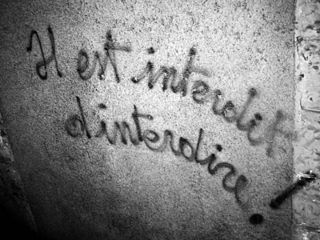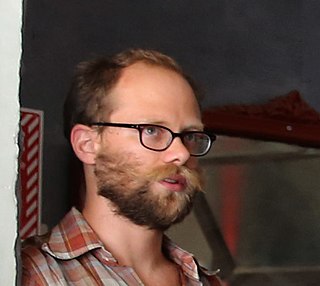
Psychogeography is the exploration of urban environments that emphasizes interpersonal connections to places and arbitrary routes. It was developed by members of the Letterist International and Situationist International, which were revolutionary groups influenced by Marxist and anarchist theory as well as the attitudes and methods of Dadaists and Surrealists.

Williamsburg is a neighborhood in the New York City borough of Brooklyn, bordered by Greenpoint to the north; Bedford–Stuyvesant to the south; Bushwick and East Williamsburg to the east; and the East River to the west. It was an independent city until 1855, when it was annexed by Brooklyn; around that time, the spelling was changed from Williamsburgh to Williamsburg.

The dérive is an unplanned journey through a landscape, usually urban, in which participants stop focusing on their everyday relations to their social environment. Developed by members of the Letterist International, it was first publicly theorized in Guy Debord's "Theory of the Dérive" (1956). Debord defines the dérive as "a mode of experimental behaviour linked to the conditions of urban society: a technique of rapid passage through varied ambiances."

Yellow Arrow was a public art project created by Christopher Allen, Brian House, and Jesse Shapins that was active from 2004 to 2006. The project is an important example of locative media and mobile phone art and draws concepts from psychogeography.
Paul Raphaelson, is an American artist best known for urban landscape photography.

Unitary urbanism (UU) was the critique of status quo "urbanism", employed by the Letterist International and then further developed by the Situationist International between 1953 and 1960.
The Workshop for Non-Linear Architecture (WNLA) was a group of experimental artists and psychogeographers. The group was active in parts of Great Britain and Glasgow during the 1990s. Based on the urban practices of the Paris-based Lettriste Internationale (1952–1957), the workshop focused on developing the Lettrist theory of Unitary Urbanism. The theory was developed through physical research and behavioral intervention.
Antediluvian Rocking Horse (ARH), formed 1994 St. Kilda, Australia, is an audio project maintained by two core artists credited as DJ2 and DJ3. DJ2 is Paul Wain, a sculptor and graduate of the Victorian College of the Arts. DJ3 is Susan King, a collage artist, writer and anti-copyright advocate. The composer Ollie Olsen was also a member. The project produces music and soundscapes that are entirely recycled from other recorded works.
Glowlab was an artist-run initiative that produced and presented experimental work related to cities and psychogeography, including interactive artworks and projects, events, exhibitions, and artists' gatherings. Brooklyn artist and curator Christina Ray launched Glowlab in 2002 as an experimental, web-based arts lab to support the visibility and expression of artists within her community. Ray produced exhibitions and projects including street-based performance work and site specific interventions both in her Williamsburg loft and in the greater urban environment. Glowlab moved from Brooklyn to Manhattan in 2008, opening an exhibition space at the edge of SoHo. As an innovative model advancing a niche collective of artists, thinkers and technologists, Glowlab produced over a dozen solo and group exhibitions, artist talks and performances. In early 2010, Ray re-launched Glowlab under her own name, continuing to focus on contemporary art, technology and creative projects examining the nature and psychology of the built environment.

Antonio Jose Guzman is a Dutch Panamanian visual artist, communication designer and lecturer. He lives and works in Amsterdam, Panama City and Dakar.

Sal Randolph is an American artist and theorist who works with issues of gift-giving, money, alternate economies, and social architecture. She founded the non-curated sound-exchange web project Opsound, which functions through the use of music released exclusively under a copyleft license, and has been cited by Lawrence Lessig as an example of how Creative Commons works to enable artists to collaborate more freely and build on each other's work. Other large-scale, collaborative projects created and implemented by Randolph include Free Manifesta and The Free Biennial, in which several hundred artists presented their work in free and open shows in New York's and Frankfurt am Main's public spaces. Artists participating in those projects included Christophe Bruno, Aram Saroyan, Swoon (artist), and Michael Cunningham, among many others.
Kate Armstrong is a Canadian artist, writer and curator with a history of projects focusing on experimental literary practices, networks and public space.

Duke Riley is an American artist. Riley earned a BFA in painting from the Rhode Island School of Design, and a MFA in Sculpture from the Pratt Institute. He lives in Brooklyn, New York. He is noted for a body of work incorporating the seafarer's craft with nautical history, as well as the host of a series of illegal clambakes on the Brooklyn waterfront for the New York artistic community. Riley told the Village Voice that he has "always been interested in the space where water meets land in the urban landscape."
Google Maps Road Trip was a live-streaming documentary produced by Marc Horowitz and Peter Baldes between August 10 and August 18, 2009. The event represented the first virtual live-streaming broadcast cross-country road trip: using only Google Maps, the pair drove from Los Angeles to Richmond, Virginia. They were interviewed by NPR Weekend Edition for their innovative "vacation". They were also mentioned in The New York Times, India's The Economic Times, The Faster Times and Readymade Magazine's blog. They streamed live on ustream.tv.

Douglas Paulson is an artist based in New York City.
Journey to the End of the Night is an urban street game. Competitors race by foot around an urban area with a visible colored ribbon. Along the way, groups of chasers attempt to tag them, and if they are successful, they remove the competitor's ribbon. Competitors can also seek refuge in designated safe zones. The first competitor to get to all designated checkpoints in order wins. In 2006, the group AntiBoredom started the game in San Francisco as an activity paired with the online/offline game SFZero, and ran it two additional times that year in New York, as part of the Psy-Geo-Conflux and the inaugural Come Out & Play festival. Variants in other cities include Survive DC. According to one organizer, urban tag "allows racers to experience the city a little differently and expand your concept of public space."

Charles Compo is a contemporary American fine artist, composer and multi-instrumentalist.
Conflux may refer to:
Robbin Ami Silverberg is an American/Canadian artist specializing in artists' books.

Kenichi Nakajima is a Japanese painter, visual artist, and performance artist. He is known for his exhibitions at the Williamsburg Art & Historical Center, including the group exhibitions Life on Earth and Togetherness and Oneness. He has also participated in exhibitions such as The Right to Silence? at the Anya and Andrew Shiva Gallery and the solo exhibition From FEET to Art.